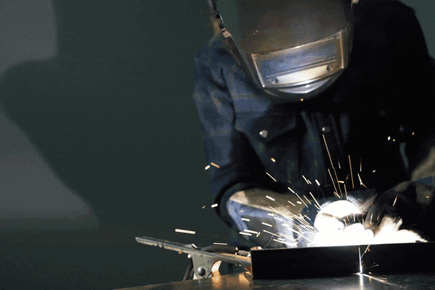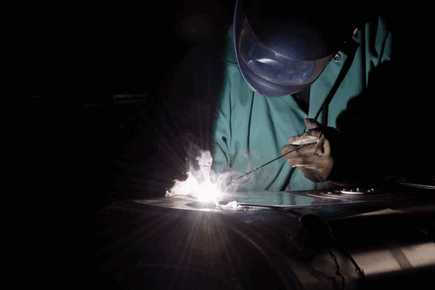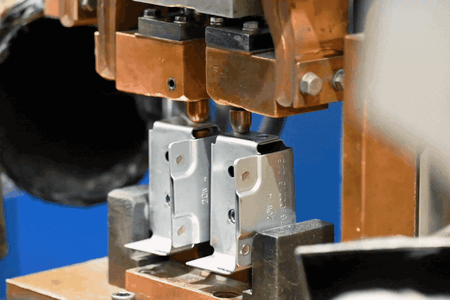Turkey's custom metal fabrication and stainless steel fabrication service.
We offer a wide range of custom (bespoke) steel fabrication metal services in Turkey.

Robotic Welding
Robotic welding is an example of automation technology that
has revolutionized welding processes in industrial production. This method
involves the use of robots to join metal parts. Robotic welding increases
production speed while at the same time ensuring precision, resulting in
higher-quality welded products at a lower cost.
At EvoSteel, we specialize in robotic welding. We offer
robotic welding solutions for industrial sectors. Robotic welding increases
production efficiency and minimizes the margin of error.
Robotic welding is preferred in automotive, metalworking,
shipbuilding, and many industrial sectors. Our company aims to improve
production processes by offering customized robotic welding solutions suitable
for the needs of these sectors.
Robots can adapt to various welding processes with the range
of machinery available, including arc, resistance, spot, TIG, laser, plasma,
and MIG welding. The main focus is creating the right welding programs and jigs
into the welding application.
Robotic Welding Applications
Robotic welding stands out with its ability to save time and
provide high efficiency in industrial production. It has gained an important
place in the metal and heavy industry where spot and laser welding are used,
especially in the automotive industry. EvoSteel, the name of our company,
offers pioneering solutions in this field. Robotic welding, which does not
require constant shifts and changes in the welding process, is ideal for short
welds with predictable actions. It can also be used effectively in industries
with curved surfaces, such as long welds, with the help of external axes.
While robotic welding is often used in mass production with
a focus on efficiency and quantity, thanks to our flexible programming
capabilities, it can be adapted to different needs and even smaller or one-off
productions. EvoSteel aims to increase productivity at every stage of
industrial production by providing customized and cost-effective solutions in
robotic welding technology.
Robotic Welding Technique
The main focus in robotic welding is on software and correct
programming. The main expenses consist of equipment, testing and training of
operators, so the robotization of the welding process always requires careful
planning. Our company, EvoSteel, needs to analyze the current state of welding
production and all its processes and costs. It is also necessary to study the
compatibility of the equipment with robotic systems.
The specifications for the right weld need to be precise. In
automated welding, welds can be measured as small as possible because they are
consistent. Consistent parts allow the robot to perform the welding
continuously in the same place. All processes can be controlled and the robot
can work thanks to pre-planned programs.
Robots perform a specific task based on input from the
operator. However, the task does not always have to be limited to welding the
same part because the robot can be reprogrammed. The robot can repeat the same
actions around the clock, but the program must be changed when the task
changes. EvoSteel aims to improve work efficiency through robotic welding
technology continuously and offers solutions to optimize this process to suit
customer needs.
Advantages of Welding Robot
Increased Productivity
Robotic welding completes jobs faster and more efficiently.
They also tend to make fewer mistakes than their human counterparts. Robotic
welders can achieve up to 85% productivity, compared to 20% for skilled human
workers.
Constant Quality
Robots don’t get distracted. They can maintain constant weld
speed, current, and other variables. Because of this, they can deliver very
high weld quality every time. Using welding robots for welding projects that
need stringent quality requirements is ideal.
Reduced Waste and Consumables
Welding robots eliminate many welding defects caused by
human welding. This is because robots do not get tired and eliminate
fatigue-related problems. Welding robots ensure the same weld quality in every
situation. Avoiding waste makes it easier to maintain the budget, especially in
high-value jobs.
Advantages of Welding Robot
Robotic Welding Applications
Robotic welding technologies can be used in various
industries, from metal fabrication to rail applications. Whatever your company
needs, robotic welding can be the perfect solution for complex metal projects.
Railroad Industry
The railway industry has to produce many different wagons
for companies throughout the year. The railway industry often receives orders
for similar wagons for months, which can result in companies placing hundreds
of orders simultaneously. For example, some railroad companies require metal
supports that join the ends of container railcars. Robotic welding technology
can help these businesses by producing a variety of supports faster.
Automotive Industry
The automotive industry requires fast production capacities
and must comply with government safety requirements. Many car parts are made
with a press brake or casting, guaranteeing that the frame is manufactured
correctly. However, welding the parts together is essential to ensure the car
becomes cohesive.
Welding can also help with other automotive applications:
Engines: Welding is critical to ensure engines
are durable and correctly positioned in the car.
Pumps: Car water pumps may require welding to
join complex metals and parts.
Metal fasteners: Metal fasteners are frequently
used in car manufacturing, and welding can help permanently join materials.
Advantages of Robotic Laser Welding
- Allows high welding speeds depending on laser power and material.
- Among the numerous advantages of laser welding, such as low heat affected zone and high processing speed.
- Due to rapid cooling, the material is not significantly affected.
- It provides weld seams with high strength, no grinding required and standard appearance.
- It can easily reach even difficult spots in narrow areas.
- It can weld two different materials together
- It is convenient to follow and position with the camera.
- Suitable for use in spot and seam welding
- Deep penetration of the parts in the weld area, low probability of distortions that can be seen during welding on the parts
- Welding can be performed with/without filler material
- Laser is a clean energy source.
- The welding robot is suitable for industrial automation
Frequently Asked Questions About Robotic Welding
What advantages does robotic welding offer?
Robotic welding can work continuously at high speed, reducing human error, ensuring repeatability, and offering high precision even in complex projects.
Which materials are suitable for robotic welding?
Generally, many metals, such as steel, aluminum, and stainless steel, can be suitable for robotic welding. However, the thickness and properties of the material can be important for welding.
Is robotic welding cost-effective?
Robotic welding can be cost-effective in the long run because it produces less waste, increases production processes' efficiency, and improves quality through repeatability. However, the initial investment cost can be high.
Other Welding Services



